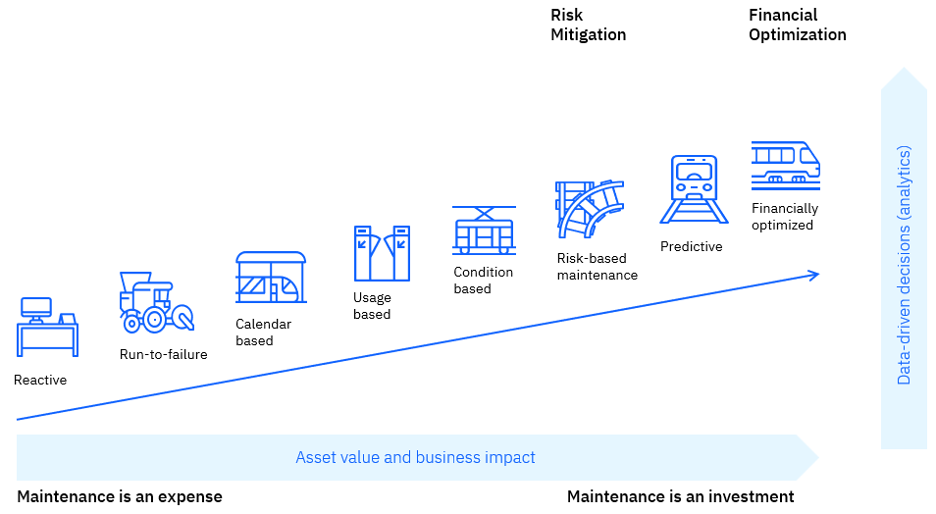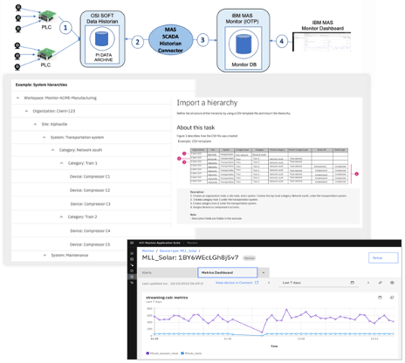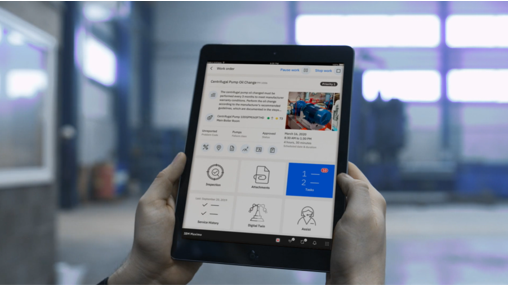The industrial sector has been increasingly using predictive maintenance to improve equipment reliability and minimise downtime. It is a type of condition-based maintenance that uses data analytics to predict when equipment is likely to fail. This allows businesses to schedule maintenance before problems occur, which can help avoid costly repairs and production disruptions.
IBM Maximo Application Suite is a software platform for predictive maintenance. It provides users with asset health insights, automated maintenance planning, and system alerts and notifications. In this blog post, we will discuss how the IBM Maximo Application Suite can help with predictive maintenance and provide a step-by-step guide on how to get started.
What is the IBM Maximo Application Suite?
Maximo Application Suite is a comprehensive software platform that helps organisations manage their physical assets more effectively. The suite includes modules for asset management, work management, inventory management, and several other ancillary applications.
The benefits of using Maximo Application Suite are many and varied but can be summarised as follows:
- Improved asset utilisation and performance
- Reduced downtime and maintenance costs
- Better visibility into the health of assets
- Enhanced safety and compliance
Benefits of IBM Maximo Application Suite
There are numerous benefits to using Maximo Application Suite in your organisation, including improved asset utilisation and performance, reduced downtime and maintenance costs, better visibility into the health of assets, and enhanced safety and compliance.
Maximo Application Suite can help you improve how you manage your assets by providing a complete picture of your asset portfolio and helping you make informed decisions about where to allocate resources. The system can also automate many asset management tasks, such as work order creation and scheduling, saving you time and money.
In addition, the suite's predictive analytics capabilities can help you identify potential problems with your assets before they occur so that you can take steps to prevent them from happening. This can ultimately lead to significant cost savings by reducing downtime and avoiding expensive repairs.
How Can the IBM Maximo Application Suite Help With Predictive Maintenance?

Predictive maintenance is condition-based maintenance that uses data analytics to predict when an asset will require maintenance. By predicting when an asset will fail, predictive maintenance can help to avoid unplanned downtime and reduce the overall cost of maintaining the asset.
Several methods can be used for predictive maintenance, including:
- analysing historical data to identify patterns that indicate when an asset is likely to fail;
- using sensors to collect data about the current condition of an asset;
- using machine learning algorithms to predict when an asset will likely fail.
The main advantages of predictive maintenance include:
- Avoid unplanned downtime: With predictive maintenance, maintenance activities are scheduled before an issue occurs, which helps avoid unexpected equipment downtime. This is particularly useful for businesses that rely heavily on their equipment to operate effectively.
- Reducing overall maintenance costs: Predictive maintenance helps reduce the overall cost of maintaining an asset by identifying issues early. This is because maintenance activities can be scheduled when they are most convenient and cost-effective rather than being forced to react to a problem when it occurs
- Improving safety: Predictive maintenance also helps improve safety by avoiding potential accidents if an asset fails unexpectedly. This is especially important in industries where equipment failure could cause injury or loss of life.
How IBM Maximo Application Suite Can Enhance Predictive Maintenance?
IBM Maximo Application Suite can enhance predictive maintenance in several ways, including:
- Providing Asset Health Insights that give users visibility into the health of their assets;
- Automating Maintenance Planning so that users can schedule preventive maintenance before issues occur;
- Sending System Alerts and Notifications to users when assets are due for preventive maintenance or if there are any potential issues with assets.
The MAS Health and Predict features provide users with predictive maintenance capabilities by delivering actionable insights based on data collected from assets. This data can be used to identify potential issues and trends, as well as to generate predictions about future asset behaviour.
Automated work order creation is a feature that automatically helps users create and schedule maintenance activities based on asset data. This can help to improve the efficiency of maintenance operations, as well as to reduce the risk of unplanned downtime.
Alerts and Notifications allow users to configure alerts that will be triggered when certain conditions are met. This can help users stay informed about potential issues with their assets and take proactive measures to avoid or mitigate problems.
How to Get Started With Predictive Maintenance in IBM Maximo Application Suite?

Predictive maintenance is an important part of any asset management strategy. IBM Maximo Application Suite can help you get started with predictive maintenance by providing a comprehensive set of tools and features.
To get started with predictive maintenance in the IBM Maximo Application Suite, follow these steps:
- Update Asset details with Installation and Decommission dates.
- Record all failure dates, downtimes, and downtime codes.
- Perform a failure report including the Failure Class, failure date, Problems, Causes and Remediations.
- Select the most critical assets for the organisation whose failure can lead to significant losses and start an IoT project or collect asset data and keep their history.
The IBM Maximo Application Suite can provide the following predictions within these four activities.
Probability of Failure
Model Description:
- Predicts imminent failures.
- Forecasts Failure Window with probability.
Inputs Required
- Timestamped IoT sensor data.
- Timestamped failure data.
Questions Answered: What are the assets that have the propensity to fail in the next 'n' days?
Prediction Outcome formats:


Factors that contribute to failure
Model Description: Root cause analysis of bad outcome.
Inputs Required
- Timestamped IoT sensor data.
- Timestamped failure data.
Questions Answered: What are the top features that contribute to failure?
Prediction Outcome formats:


Predicted failure date
Model Description:
- Predicts when the next failures will occur.
- Determine if an asset is well-maintained.
- Adjust Maintenance Schedule.
Inputs Required
- Timestamped IoT sensor data.
- Timestamped failure data.
Questions Answered:
- How many days until the system fails?
- How do particular circumstances, characteristics, or causes increase or decrease the probability of survival or failure?
Prediction Outcome formats:

Anomaly detection
Model Description:
- Detect anomalies in data.
- Leveraged with sparse failure event data.
Inputs Required
- Timestamped IoT sensor data.
- Timestamped failure data.
- Validation Data for anomaly scoring.
Questions Answered: What are the assets or entities that show anomalous behaviour?
Prediction Outcome formats:


Asset life curve
Model Description: Estimate the probability of end-of-life failure.
Inputs Required
- Asset metadata.
- Installation Date.
- Decommission Date.
Questions Answered: What is the failure probability when the asset is “n” years old?
Prediction Outcome formats:

Conclusion
Based on the evidence, it can be concluded that the IBM Maximo Application Suite is an incredibly valuable tool for predictive maintenance. This suite provides deep insights into the health of assets, allowing organisations to identify potential issues before they become major problems. With automated maintenance planning, organisations can prioritise their maintenance efforts and ensure that their assets always operate at peak performance. In addition, the system provides alerts and notifications to key personnel when critical issues arise, further streamlining the maintenance process.
Organisations can significantly improve their predictive maintenance processes by using the IBM Maximo Application Suite. The suite allows organisations to create a more data-driven approach to maintenance, allowing them to make informed decisions about which assets need maintenance and when. This approach can lead to significant cost savings by reducing the need for reactive maintenance and extending the lifespan of assets.
To get started with the IBM Maximo Application Suite for predictive maintenance, organisations should follow the step-by-step guide provided as a kickoff point for other projects. It is also essential to keep in mind some tips for a successful implementation, such as ensuring that the suite is aligned with business goals and that users are adequately trained on how to use the system. For more information or to discuss how MAS can benefit your organisation, please do not hesitate to contact us.




